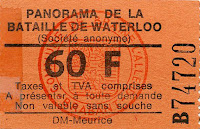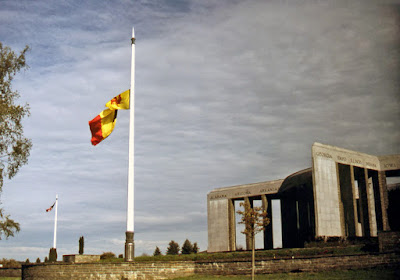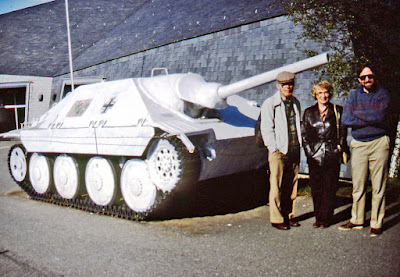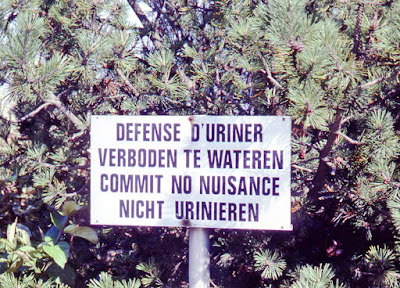The wind was whistling
against the windows all night, but we slept well. After breakfast, we left
about 8:30 and caught the #29 bus. The machine would not stamp the 10th ride, but we rode anyway.
 |
| 10-ride ticket |
We noticed that no one was carrying umbrellas today; a good sign? It was fairly sunny. We took the Metro to the Central Station to
catch the 9:31 train to Antwerp, or Anvers as the conductor asked in French.
Saw a guy eating a hot dog with sauerkraut. Saw greenhouses near Kontich. The
sun is creating silhouettes of gray clouds, worthy of a cloudscape painting.
Saw an interesting brick water tower for the railroad, with white brick design
patterns. The bridges of the train tracks in Antwerp had stone turrets along
the walls. Arrived at 10:13 and were immediately impressed by the huge station
with the old glassed-in hall and clock, and the ornate lobby.
 |
| Antwerp train station |
Built in 1895-1905, it is now a national monument, but it is being restored, as much of Europe continues to hide behind scaffolding. Out to Konigin Astridplein, a large square surrounded by cafés and cinemas. We went to Pierrot, sort of a fast food café, to have coffee and hot chocolate, and share a chocolate pastry and a huge butter croissant. Very flaky. There are a lot of pastry shops in Belgium, where we have drooled at window displays. We walked down de Keyserlei and crossed the Ring; a big city look to the area.
 |
| Old and new: View down Keyserlei from Frankrijklei |
We took an alley over to the Lange Nieuwstraat to find St Jakob’s church, which was open as a museum. It was built in 1491 by the older Waghemakere.
 |
| Sint Jaconskerk/St James Church |
Could not determine the carved marble communion table by Hendrick Frans Verbruggen (along with Kerricx in the 17th century), but have since seen he is a prolific sculptor! Willem Kerricx did the painting of the Apotheosis of St James, the thing topping the altarpiece, I believe! Peeked into the choir to see the wooden carved choirstalls by Artus Quellin, with family coats of arms of benefactors, of which Peter Paul Rubens was one. In the fourth chapel around the back was the marked tomb of Rubens, with his painting of the Holy Family above the chapel altar. In cases around the choir were liturgical vestments and articles, books, etc.Also photos of the remains of Rubens!
Left and crossed the street where you had to stay within the curb so as not to get brushed by a passing tram! Down an alley to the restored 19th century galleried Bourse/Beurs, a commercial exchange dated 1564, with wrought-iron pieces supporting the ceilings, and coats of arms and maps on the walls.
 |
| Bourse/former stock exchange |
Now is it a shortcut or an exhibition hall? Crossing Meir Street, we looked down to see the
Torengebouw/Tower bock na
med Boerentoren, a 24-story early skyscraper, the first in Europe.
 |
| Boerentoren (1928-1931) |
We made a wrong turn and ended up at the circular end of the city Bourla Theater (1829-1834) with busts of Mozart, Molière Racine, etc. Saw a bust of Racine in the Brussels art gallery between old and new along with George Washington! Passed the Mayer van den Bergh Museum in a house built by his mother to house his collection, next to a modern glass building.
 |
| Mayer van der Bergh House (1901-1904) |
 |
| Unusual building |
Went to
Sint Augustinus/St Augustine’s (1615-1618 designed by Wenzel Coebergher) to view a Peter Paul Rubens and Jan van Eyck paintings, but the early Baroque church was changed into an exhibition hall, with an exhibit on monuments (including the Statue of Liberty) with mostly photos. Went down another alley past interesting wooden doors to find the locked up
Sint Andrieskerk/St Andrew’s Church (1513, expanded 1529), so no look at a Pourbus portrait of Mary, Queen of Scots. Walked all around it at first, but finally found the Plantin-Moretus Museum on a small square with a flea market of antiques and auction with crowds of people standing around.
The origins of the market was in public sales by the bailiff of debtors’ impounded goods. We paid 50 BEF/$1.30 to enter the museum, in a 16th century house of a French painter who named type-faces.
 |
| Plantin-Moretus Museum ticket |
He was commissioned by Philip II and was made the Archtypographer Royal. This was the most important printing shop of his time, with 22 presses and printing 50-60 volumes a year. It was also a meeting place of the International Humanist thinkers. We were guided from room to room, some set up as in the period, and most with display cases of a variety of books, from handwritten and illuminated texts and manuscripts from the 9-16th centuries, to early printed volumes, and examples of works done by Plantin presses. Ended up in the proof-reader’s room, then went through several libraries. Saw copper and wood block print plates, and a great amount of type-faces, including scripts of other languages, music, etc. Went through the printing room with a good dozen presses.
Upstairs we saw the type foundry, where they made the type using punches to make molds, then creating the type. There was also a bedroom, dining room, and kitchen off the Renaissance courtyard with ivy on the walls.
 |
| Plantin-Moretus Museum |
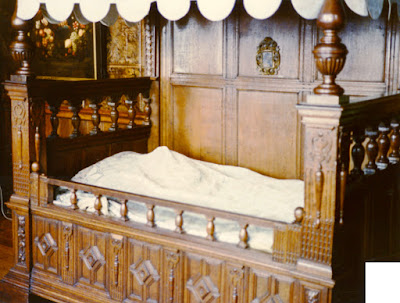 |
| Bed (KSS) |
In these rooms were tapestries, and works of art including numerous portraits by Rubens, eighteen they say! Plus furniture, Dutch tile stoves, leather walls with intricate punched designs (“gilt Spanish leather”), stained glass in the windows, wood-beamed ceilings, creaky wood floors, and plank doors between rooms. From upstairs we could look down on the antique market.
 |
| Flea market |
The museum was quite extensive.
Next we headed to the Grote Markt and bought some French fries with mayonnaise to nibble at noon.
 |
| Grote Markt |
At one side of the market we saw the house where Anthony van Dyck was born. In the center of this square was a statue of Salvius Brabo, a Roman centurion and hero to the city because he overcame the giant Antigon who terrorized the port by severing the hands of marines who didn’t pay the toll to enter the Scholde River.
 |
| Brabo Fountain |
 |
| Salvius Brabo statue (1887 by Jef Lambeaux) |
Brabo gave the giant the same fate by cutting off his hand and throwing it into the river. The name of the city comes from the word for hand (ant), and to throw (werpen). The statue’s fountain was in a slightly depressed area, with no basin.
Behind it was the Town Hall, designed by Cornelius Floris de Vriendt, but it was burned by the Spaniards in 1576, and restored in 1579.
 |
| Stadhuis/Town Hall |
The square was surrounded by guildhouses, the most opulent from the 16th century.
 |
| Guildhouses on north side of square |
 |
| Fountain in Handshoenmarkt |
We headed to the
Onze Lieve Vrouwekathedraal/Antwerp Cathedral of Our Lady and paid 3 BEF/8 cents each to enter. Set up like a museum also; it seems churches are no longer churches in Belgium. This is the largest Gothic church in the Lowlands, begun in 1352 by Appelmans and son, and in the 15th century the de Waghemakeres added to it. In 1520, de Waghemakere, Jr and Malinois Keldermans worked on the tower (they also restored The Steen). Philip II, keeping traditions of the House of Burgundy, revived the Order of the Golden Fleece chapter in 1555. Then in 1565-1566 and 1581, the iconoclasts smashed the statuary, damaging the church. In 1794-1800, during the French Occupation, the place was plundered, taking the Rubens paintings and removing the stained glass. The church was deconsecrated. Part of the treasure was recovered in 1816 after the fall of Napoleon. Rubens’ “Elevation of the Cross” was being restored, but could be seen to note the Italian influence on his painting after a trip to Italy. Up front in the makeshift nave was the triptych of “The Deposition” by Rubens, which was done later in 1614 in a more mature style. There was an “Assumption” (1626) over the altar, done in his fluffy style. Saw a “Last Supper” (1503) by Nicolas Rumbouts, and lots of Verbruggen sculptures, including a marble communion rail to the right of the center altar. There was stained glass, a Madonna of Antwerp in a flowing blue cape, Verbruggen carved confessionals, lots of sculptures and paintings by Quellins, some liturgical treasures, etc. Peeked at the transept crossing and apse where they are presently uncovering the crypts, and saw a skeleton being uncovered. I bought a few postcards for 60 BEF/$1.60 and we exited out back to Groenplats, which was not green as the name implies, but cobbled. There was a statue of Peter Paul Rubens.
 |
| Peter Paul Rubens statue (1843) by Willem Geefs |
We headed towards the river on some shopping streets, passing an abandoned medieval building with bars in the windows. Arrived at
Sint Paulus/St Paul’s church, a 16th century Gothic exterior, where the local hookers saved the paintings from a fire in the 1960s. The church was closed in the afternoons in the winter, so we couldn’t see yet another Rubens painting.
 |
| St Paul's Church |
A basketball court in the square.
 |
| Basketball court |
 |
| Fancy parking lot on Ernest van Dijkkaai |
Walked to the river for a glimpse of Metropole, the 5th largest port in the world with the fastest turn-around time. It came into its own when the Zwin River silted up in the 15th century, closing the Bruges port.
 |
| Barge on the River Schelde |
 |
| View towards the port |
We walked to Steen Castle, one of the few traces of medieval Antwerp dating to the 9-10th centuries, but much of it no older than 1520. Started out as a fortification, and in the 13th century it was a prison, but now is a Maritime Museum. At the entrance ramp was a statue of the Lange Wapper, two little sailors looking up between the legs of a giant.
 |
| Steen Castle and the Lange Wapper statue (1963 by Albert Poels) |
 |
| Steen Castle entrance |
We went up to a terrace to look back over the city.
 |
| View down Suikerrui towards Antwerp Cathedral |
Passed a Jesuit church, then made our way back towards Roosevelt Plats.
 |
| St Carolus Borromeuskerk/Jesuit Church (1621) |
Passed the opera and followed Pelikanstraat with all the gold and diamond shops. Did some window shopping in the diamond quarter, but did not see anything unique and appealing. Antwerp has 500 years of diamond cutting experience, and its own diamond bourse/exchange. Forty percent of the world’s diamond cutting and sixty percent of the dealing is done here. Originally most of their diamonds came from India.
Found the restaurant Gianni on De Keyserlei to have lunch. I had a Perrier with cheese croquettes and French fries, and Kent had a Belle Vue Geuze beer with a cheese omelet; both dishes were garnished with lettuce, a tomato wedge, grated carrot, as well as mayonnaise with a tiny radish stuck in it, and a twist of cucumber. Service seems to be included, so we left 500 BEF/$13 for the 460 BEF/$12 bill. We changed more money, and headed to the other side of the train station to Dierentuin, the zoo; one of the most modern zoological gardens in Europe. Still looks ancient to us, but they are working on it. A lot was closed due to construction. We didn’t see the light curtain in the aviary, in fact, we didn’t find any aviary, nor the cold air curtain to keep in the pythons. Fortunately they were in typical glass enclosures in the reptile house. Saw lots of monkeys and many gorillas. Lots of southeastern species and a few others with which we weren’t familiar.
 |
| Okapia johnstoni/Okapi |
 |
| Zoo garden |
 |
| Probably a Castor canadensis/North American Beaver |
At feeding time the eagles were given white rats, and the monkeys picked out the banana pieces and peeled them. It appeared the male monkeys had first dibs on the food. One species of monkeys was given large bird fetuses to eat. Saw a wandering two-horned rhino, and heard and saw a roaring lion.
 |
| Probably a Ceratotherium simum/White Rhinoceros |
Went through the
aquarium quickly. There seemed to be a lot of one species, with five boa
constrictors in one enclosure, 100 turtles in a pool, etc. Saw 4-horned sheep
from Scotland next to the bighorn sheep, and a stable of “very dangerous”
animals, being long-horned cattle varieties, a bison, and a dark and shaggy
yak. Lots of ink flamingos and generally very healthy-looking animals. There
was a newborn gibbon with a showoff father. Peeked into the delphinarium before
being ushered out at closing time, and before that the nocturama with half the
animals sleeping! Paid 260 BEF/$6.85, where it seemed most of the people were
dressed up!









